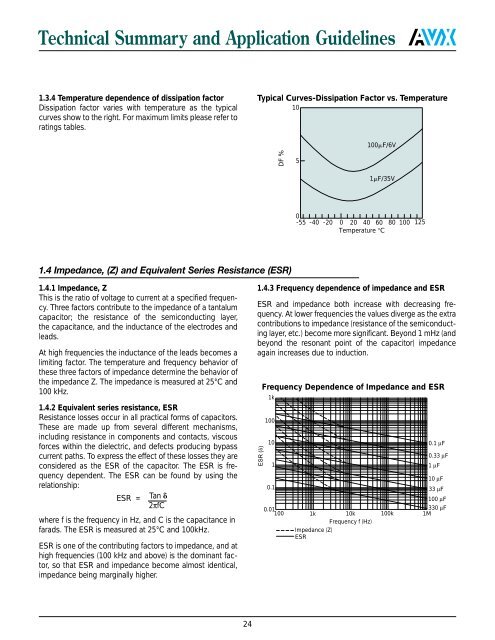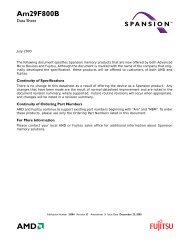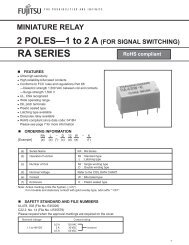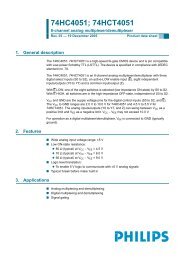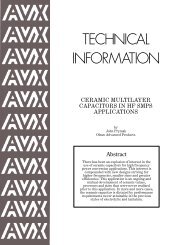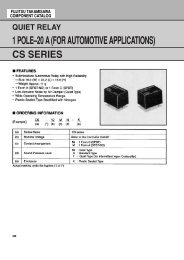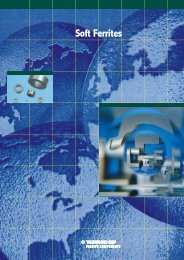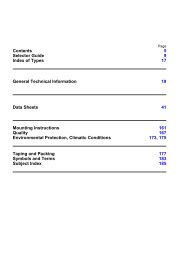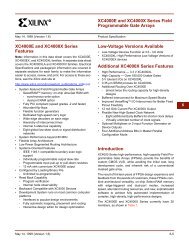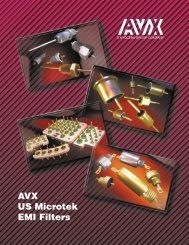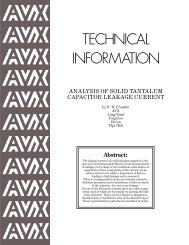AVX Tantalum Leaded Capacitors - RYSTON Electronics sro
AVX Tantalum Leaded Capacitors - RYSTON Electronics sro
AVX Tantalum Leaded Capacitors - RYSTON Electronics sro
Create successful ePaper yourself
Turn your PDF publications into a flip-book with our unique Google optimized e-Paper software.
Technical Summary and Application Guidelines<br />
1.3.4 Temperature dependence of dissipation factor<br />
Dissipation factor varies with temperature as the typical<br />
curves show to the right. For maximum limits please refer to<br />
ratings tables.<br />
Typical Curves-Dissipation Factor vs. Temperature<br />
10<br />
100F/6V<br />
DF %<br />
5<br />
1F/35V<br />
0<br />
-55 -40 -20 0 20 40 60 80 100 125<br />
Temperature °C<br />
1.4 Impedance, (Z) and Equivalent Series Resistance (ESR)<br />
1.4.1 Impedance, Z<br />
This is the ratio of voltage to current at a specified frequency.<br />
Three factors contribute to the impedance of a tantalum<br />
capacitor; the resistance of the semiconducting layer,<br />
the capacitance, and the inductance of the electrodes and<br />
leads.<br />
At high frequencies the inductance of the leads becomes a<br />
limiting factor. The temperature and frequency behavior of<br />
these three factors of impedance determine the behavior of<br />
the impedance Z. The impedance is measured at 25°C and<br />
100 kHz.<br />
1.4.2 Equivalent series resistance, ESR<br />
Resistance losses occur in all practical forms of capacitors.<br />
These are made up from several different mechanisms,<br />
including resistance in components and contacts, viscous<br />
forces within the dielectric, and defects producing bypass<br />
current paths. To express the effect of these losses they are<br />
considered as the ESR of the capacitor. The ESR is frequency<br />
dependent. The ESR can be found by using the<br />
relationship:<br />
ESR = Tan <br />
2πfC<br />
where f is the frequency in Hz, and C is the capacitance in<br />
farads. The ESR is measured at 25°C and 100kHz.<br />
ESR is one of the contributing factors to impedance, and at<br />
high frequencies (100 kHz and above) is the dominant factor,<br />
so that ESR and impedance become almost identical,<br />
impedance being marginally higher.<br />
1.4.3 Frequency dependence of impedance and ESR<br />
ESR and impedance both increase with decreasing frequency.<br />
At lower frequencies the values diverge as the extra<br />
contributions to impedance (resistance of the semiconducting<br />
layer, etc.) become more significant. Beyond 1 mHz (and<br />
beyond the resonant point of the capacitor) impedance<br />
again increases due to induction.<br />
ESR ()<br />
Frequency Dependence of Impedance and ESR<br />
1k<br />
100<br />
10<br />
1<br />
0.1 µF<br />
0.33 µF<br />
1 µF<br />
10 µF<br />
0.1<br />
33 µF<br />
100 µF<br />
0.01<br />
330 µF<br />
100 1k 10k 100k 1M<br />
Frequency f (Hz)<br />
Impedance (Z)<br />
ESR<br />
24


